Yang Cao
Sherman
Context and Diversity Matter: The Emergence of In-Context Learning in World Models
Sep 26, 2025Abstract:The capability of predicting environmental dynamics underpins both biological neural systems and general embodied AI in adapting to their surroundings. Yet prevailing approaches rest on static world models that falter when confronted with novel or rare configurations. We investigate in-context environment learning (ICEL), shifting attention from zero-shot performance to the growth and asymptotic limits of the world model. Our contributions are three-fold: (1) we formalize in-context learning of a world model and identify two core mechanisms: environment recognition and environment learning; (2) we derive error upper-bounds for both mechanisms that expose how the mechanisms emerge; and (3) we empirically confirm that distinct ICL mechanisms exist in the world model, and we further investigate how data distribution and model architecture affect ICL in a manner consistent with theory. These findings demonstrate the potential of self-adapting world models and highlight the key factors behind the emergence of ICEL, most notably the necessity of long context and diverse environments.
Oblivionis: A Lightweight Learning and Unlearning Framework for Federated Large Language Models
Aug 12, 2025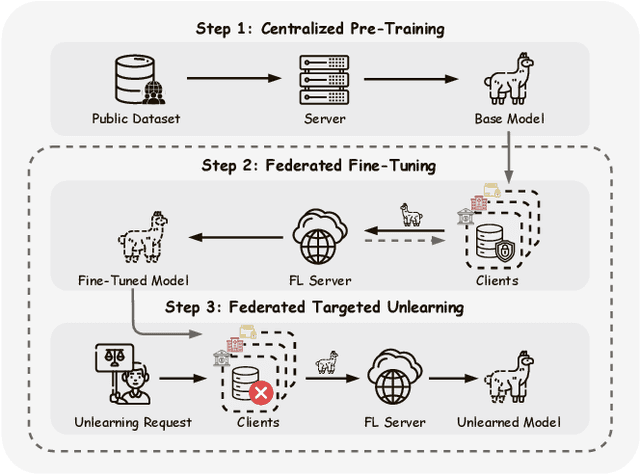

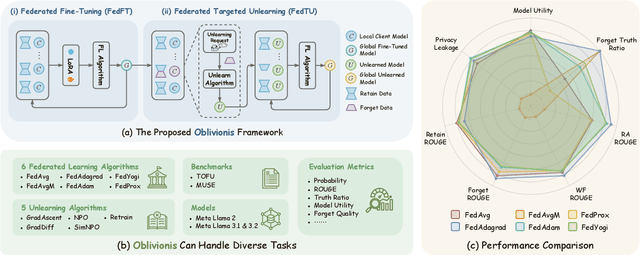
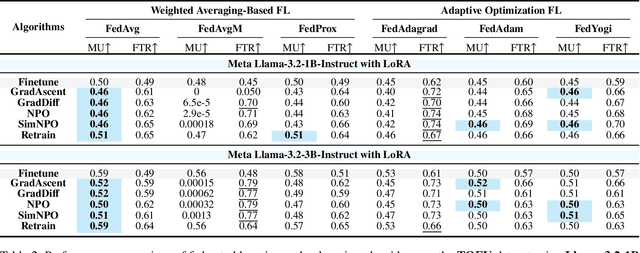
Abstract:Large Language Models (LLMs) increasingly leverage Federated Learning (FL) to utilize private, task-specific datasets for fine-tuning while preserving data privacy. However, while federated LLM frameworks effectively enable collaborative training without raw data sharing, they critically lack built-in mechanisms for regulatory compliance like GDPR's right to be forgotten. Integrating private data heightens concerns over data quality and long-term governance, yet existing distributed training frameworks offer no principled way to selectively remove specific client contributions post-training. Due to distributed data silos, stringent privacy constraints, and the intricacies of interdependent model aggregation, federated LLM unlearning is significantly more complex than centralized LLM unlearning. To address this gap, we introduce Oblivionis, a lightweight learning and unlearning framework that enables clients to selectively remove specific private data during federated LLM training, enhancing trustworthiness and regulatory compliance. By unifying FL and unlearning as a dual optimization objective, we incorporate 6 FL and 5 unlearning algorithms for comprehensive evaluation and comparative analysis, establishing a robust pipeline for federated LLM unlearning. Extensive experiments demonstrate that Oblivionis outperforms local training, achieving a robust balance between forgetting efficacy and model utility, with cross-algorithm comparisons providing clear directions for future LLM development.
Towards High-Order Mean Flow Generative Models: Feasibility, Expressivity, and Provably Efficient Criteria
Aug 09, 2025Abstract:Generative modelling has seen significant advances through simulation-free paradigms such as Flow Matching, and in particular, the MeanFlow framework, which replaces instantaneous velocity fields with average velocities to enable efficient single-step sampling. In this work, we introduce a theoretical study on Second-Order MeanFlow, a novel extension that incorporates average acceleration fields into the MeanFlow objective. We first establish the feasibility of our approach by proving that the average acceleration satisfies a generalized consistency condition analogous to first-order MeanFlow, thereby supporting stable, one-step sampling and tractable loss functions. We then characterize its expressivity via circuit complexity analysis, showing that under mild assumptions, the Second-Order MeanFlow sampling process can be implemented by uniform threshold circuits within the $\mathsf{TC}^0$ class. Finally, we derive provably efficient criteria for scalable implementation by leveraging fast approximate attention computations: we prove that attention operations within the Second-Order MeanFlow architecture can be approximated to within $1/\mathrm{poly}(n)$ error in time $n^{2+o(1)}$. Together, these results lay the theoretical foundation for high-order flow matching models that combine rich dynamics with practical sampling efficiency.
UniMC: Taming Diffusion Transformer for Unified Keypoint-Guided Multi-Class Image Generation
Jul 03, 2025Abstract:Although significant advancements have been achieved in the progress of keypoint-guided Text-to-Image diffusion models, existing mainstream keypoint-guided models encounter challenges in controlling the generation of more general non-rigid objects beyond humans (e.g., animals). Moreover, it is difficult to generate multiple overlapping humans and animals based on keypoint controls solely. These challenges arise from two main aspects: the inherent limitations of existing controllable methods and the lack of suitable datasets. First, we design a DiT-based framework, named UniMC, to explore unifying controllable multi-class image generation. UniMC integrates instance- and keypoint-level conditions into compact tokens, incorporating attributes such as class, bounding box, and keypoint coordinates. This approach overcomes the limitations of previous methods that struggled to distinguish instances and classes due to their reliance on skeleton images as conditions. Second, we propose HAIG-2.9M, a large-scale, high-quality, and diverse dataset designed for keypoint-guided human and animal image generation. HAIG-2.9M includes 786K images with 2.9M instances. This dataset features extensive annotations such as keypoints, bounding boxes, and fine-grained captions for both humans and animals, along with rigorous manual inspection to ensure annotation accuracy. Extensive experiments demonstrate the high quality of HAIG-2.9M and the effectiveness of UniMC, particularly in heavy occlusions and multi-class scenarios.
AliTok: Towards Sequence Modeling Alignment between Tokenizer and Autoregressive Model
Jun 05, 2025Abstract:Autoregressive image generation aims to predict the next token based on previous ones. However, existing image tokenizers encode tokens with bidirectional dependencies during the compression process, which hinders the effective modeling by autoregressive models. In this paper, we propose a novel Aligned Tokenizer (AliTok), which utilizes a causal decoder to establish unidirectional dependencies among encoded tokens, thereby aligning the token modeling approach between the tokenizer and autoregressive model. Furthermore, by incorporating prefix tokens and employing two-stage tokenizer training to enhance reconstruction consistency, AliTok achieves great reconstruction performance while being generation-friendly. On ImageNet-256 benchmark, using a standard decoder-only autoregressive model as the generator with only 177M parameters, AliTok achieves a gFID score of 1.50 and an IS of 305.9. When the parameter count is increased to 662M, AliTok achieves a gFID score of 1.35, surpassing the state-of-the-art diffusion method with 10x faster sampling speed. The code and weights are available at https://github.com/ali-vilab/alitok.
PMQ-VE: Progressive Multi-Frame Quantization for Video Enhancement
May 18, 2025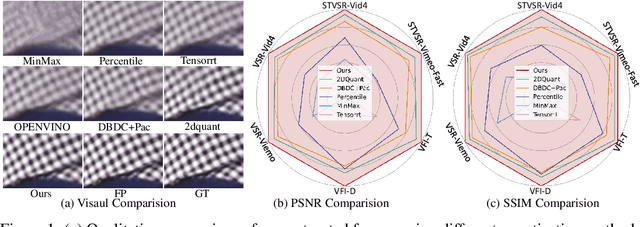
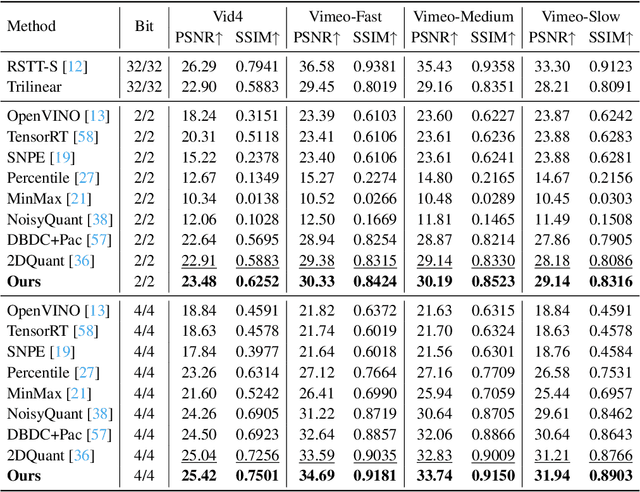
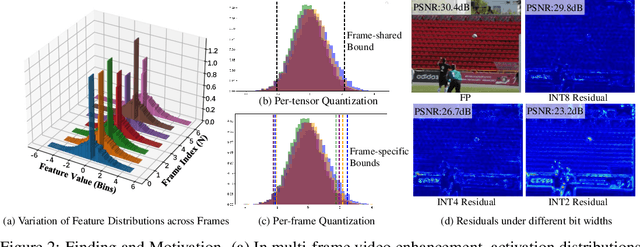

Abstract:Multi-frame video enhancement tasks aim to improve the spatial and temporal resolution and quality of video sequences by leveraging temporal information from multiple frames, which are widely used in streaming video processing, surveillance, and generation. Although numerous Transformer-based enhancement methods have achieved impressive performance, their computational and memory demands hinder deployment on edge devices. Quantization offers a practical solution by reducing the bit-width of weights and activations to improve efficiency. However, directly applying existing quantization methods to video enhancement tasks often leads to significant performance degradation and loss of fine details. This stems from two limitations: (a) inability to allocate varying representational capacity across frames, which results in suboptimal dynamic range adaptation; (b) over-reliance on full-precision teachers, which limits the learning of low-bit student models. To tackle these challenges, we propose a novel quantization method for video enhancement: Progressive Multi-Frame Quantization for Video Enhancement (PMQ-VE). This framework features a coarse-to-fine two-stage process: Backtracking-based Multi-Frame Quantization (BMFQ) and Progressive Multi-Teacher Distillation (PMTD). BMFQ utilizes a percentile-based initialization and iterative search with pruning and backtracking for robust clipping bounds. PMTD employs a progressive distillation strategy with both full-precision and multiple high-bit (INT) teachers to enhance low-bit models' capacity and quality. Extensive experiments demonstrate that our method outperforms existing approaches, achieving state-of-the-art performance across multiple tasks and benchmarks.The code will be made publicly available at: https://github.com/xiaoBIGfeng/PMQ-VE.
GRACE: Estimating Geometry-level 3D Human-Scene Contact from 2D Images
May 10, 2025Abstract:Estimating the geometry level of human-scene contact aims to ground specific contact surface points at 3D human geometries, which provides a spatial prior and bridges the interaction between human and scene, supporting applications such as human behavior analysis, embodied AI, and AR/VR. To complete the task, existing approaches predominantly rely on parametric human models (e.g., SMPL), which establish correspondences between images and contact regions through fixed SMPL vertex sequences. This actually completes the mapping from image features to an ordered sequence. However, this approach lacks consideration of geometry, limiting its generalizability in distinct human geometries. In this paper, we introduce GRACE (Geometry-level Reasoning for 3D Human-scene Contact Estimation), a new paradigm for 3D human contact estimation. GRACE incorporates a point cloud encoder-decoder architecture along with a hierarchical feature extraction and fusion module, enabling the effective integration of 3D human geometric structures with 2D interaction semantics derived from images. Guided by visual cues, GRACE establishes an implicit mapping from geometric features to the vertex space of the 3D human mesh, thereby achieving accurate modeling of contact regions. This design ensures high prediction accuracy and endows the framework with strong generalization capability across diverse human geometries. Extensive experiments on multiple benchmark datasets demonstrate that GRACE achieves state-of-the-art performance in contact estimation, with additional results further validating its robust generalization to unstructured human point clouds.
Vision-Language-Action Models: Concepts, Progress, Applications and Challenges
May 07, 2025Abstract:Vision-Language-Action (VLA) models mark a transformative advancement in artificial intelligence, aiming to unify perception, natural language understanding, and embodied action within a single computational framework. This foundational review presents a comprehensive synthesis of recent advancements in Vision-Language-Action models, systematically organized across five thematic pillars that structure the landscape of this rapidly evolving field. We begin by establishing the conceptual foundations of VLA systems, tracing their evolution from cross-modal learning architectures to generalist agents that tightly integrate vision-language models (VLMs), action planners, and hierarchical controllers. Our methodology adopts a rigorous literature review framework, covering over 80 VLA models published in the past three years. Key progress areas include architectural innovations, parameter-efficient training strategies, and real-time inference accelerations. We explore diverse application domains such as humanoid robotics, autonomous vehicles, medical and industrial robotics, precision agriculture, and augmented reality navigation. The review further addresses major challenges across real-time control, multimodal action representation, system scalability, generalization to unseen tasks, and ethical deployment risks. Drawing from the state-of-the-art, we propose targeted solutions including agentic AI adaptation, cross-embodiment generalization, and unified neuro-symbolic planning. In our forward-looking discussion, we outline a future roadmap where VLA models, VLMs, and agentic AI converge to power socially aligned, adaptive, and general-purpose embodied agents. This work serves as a foundational reference for advancing intelligent, real-world robotics and artificial general intelligence. >Vision-language-action, Agentic AI, AI Agents, Vision-language Models
Can Differentially Private Fine-tuning LLMs Protect Against Privacy Attacks?
May 01, 2025Abstract:Fine-tuning large language models (LLMs) has become an essential strategy for adapting them to specialized tasks; however, this process introduces significant privacy challenges, as sensitive training data may be inadvertently memorized and exposed. Although differential privacy (DP) offers strong theoretical guarantees against such leakage, its empirical privacy effectiveness on LLMs remains unclear, especially under different fine-tuning methods. In this paper, we systematically investigate the impact of DP across fine-tuning methods and privacy budgets, using both data extraction and membership inference attacks to assess empirical privacy risks. Our main findings are as follows: (1) Differential privacy reduces model utility, but its impact varies significantly across different fine-tuning methods. (2) Without DP, the privacy risks of models fine-tuned with different approaches differ considerably. (3) When DP is applied, even a relatively high privacy budget can substantially lower privacy risk. (4) The privacy-utility trade-off under DP training differs greatly among fine-tuning methods, with some methods being unsuitable for DP due to severe utility degradation. Our results provide practical guidance for privacy-conscious deployment of LLMs and pave the way for future research on optimizing the privacy-utility trade-off in fine-tuning methodologies.
Learning Multi-view Multi-class Anomaly Detection
Apr 30, 2025Abstract:The latest trend in anomaly detection is to train a unified model instead of training a separate model for each category. However, existing multi-class anomaly detection (MCAD) models perform poorly in multi-view scenarios because they often fail to effectively model the relationships and complementary information among different views. In this paper, we introduce a Multi-View Multi-Class Anomaly Detection model (MVMCAD), which integrates information from multiple views to accurately identify anomalies. Specifically, we propose a semi-frozen encoder, where a pre-encoder prior enhancement mechanism is added before the frozen encoder, enabling stable cross-view feature modeling and efficient adaptation for improved anomaly detection. Furthermore, we propose an Anomaly Amplification Module (AAM) that models global token interactions and suppresses normal regions to enhance anomaly signals, leading to improved detection performance in multi-view settings. Finally, we propose a Cross-Feature Loss that aligns shallow encoder features with deep decoder features and vice versa, enhancing the model's sensitivity to anomalies at different semantic levels under multi-view scenarios. Extensive experiments on the Real-IAD dataset for multi-view multi-class anomaly detection validate the effectiveness of our approach, achieving state-of-the-art performance of 91.0/88.6/82.1 and 99.1/43.9/48.2/95.2 for image-level and the pixel-level, respectively.
 Add to Chrome
Add to Chrome Add to Firefox
Add to Firefox Add to Edge
Add to Edge